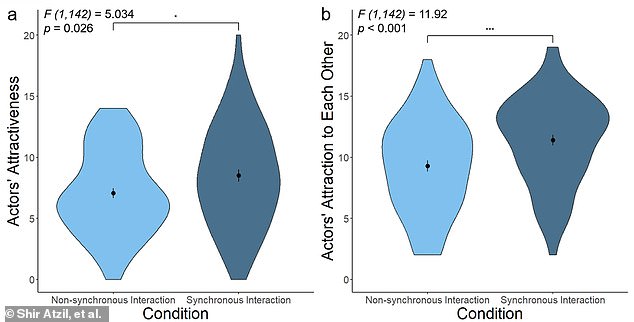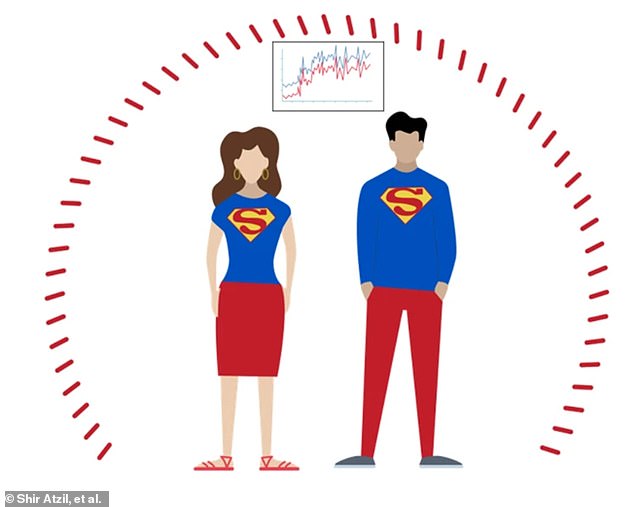Are YOU a ‘Super Synchroniser’? Some singles have the unique ability to sync their heartbeats with potential partners – and they’re more likely to score a second date
When it comes to dating, some people seem to have a certain knack for making a good first impression.
Scientists now claim that the smoothness of some singles may be due to a unique ability to synchronise bodily functions, such as heart rate, with those of their date.
A study from the Hebrew University in Jerusalem shows that ‘Supersynchronizers’ can unconsciously attune themselves to their partner’s body rhythm.
And the researchers discovered that people with this strange gift are found more attractive by others.
Lead researcher Dr Shir Atzil told MailOnline: ‘If a particular partner can enhance our physiological regulation, we have a biological reason to be attracted to him or her.’
Scientists say some singles’ dating success could be down to a unique ability to sync their body rhythms with those of their date (stock image)
Physiological synchrony is the way in which some people’s bodily functions are unconsciously coordinated.
When certain people interact with each other, their heart rates, breathing patterns, skin conductance, and even hormone functions can come into balance.
Researchers have long known that synchronicity appears to play a role in successful romantic relationships.
For example, research has shown that couples whose heart rate and breathing are in sync experience greater satisfaction in their relationship.
To see whether physiological synchronicity also plays a role in the early stages of romantic attraction, the researchers conducted two experiments.
In the first study, 144 participants watched a 92-second video of people acting either synchronously or non-synchronously.

Researchers showed 144 participants videos of themselves performing in highly synchronized (dark gray) and poorly synchronized (light blue) ways. These graphs show how the actors themselves were perceived as more attractive (left) and had more mutual attraction (right) when they were synchronized
Participants were then asked to rate the attractiveness of both the man and the woman in the video and to rate the degree of mutual attraction between the actors.
The researchers found that participants found both parties more attractive when they interacted in a synchronized manner.
Participants also rated the degree of mutual attraction between the actors as higher when they saw them in a scenario with higher synchronicity.
Subsequently, 48 additional participants, 24 men and 24 women, were selected to participate in a second experiment to investigate how synchronicity influences attractiveness.
Each participant was sent on four five-minute speed dates with other participants in a ‘homely’ laboratory.

In a second experiment, participants were sent on 5-minute speed dates while researchers measured their physiological arousal via electrodermal activity
During the dates, the researchers measured the participants’ electrodermal activity, a measure of their physiological arousal.
Before and after each date, participants indicated how attracted they felt to their partner.
These scores were then averaged to give everyone an individual ‘Romantic Attractiveness Score’.
Researchers also measured how much their electrodermal activity was synchronized with that of their date to assess their synchronization ability.
They found that although initial attractiveness was not related to the ability to synchronize, people with higher synchrony scores were rated more attractive after the date.
Dr. Atzil says, “Initial attraction does not predict synchrony during a speed date, whereas synchrony during a date does predict greater attraction.”

Some participants were classified as “super-synchronizers” who could exhibit high levels of synchronicity regardless of who or what they were in contact with.
The researchers also found that some participants had a particularly strong ability to synchronize with their partners.
The abilities of these Super Synchronisers were so great that researchers discovered they could even synchronize the rhythms of their bodies with those of inanimate objects, such as metronomes.
Dr. Atzil says, “Supersynchronizers are rated as more attractive. The online experiment showed that the same people are rated as more attractive when they are in sync than when they are not in sync.
“This suggests that synchrony is attractive.”
The researchers believe this ability to synchronize is so attractive because it signals an underlying biological or reproductive fitness.
One of the theories scientists use to explain why we are attracted to people is that we look for qualities that indicate a partner has useful traits.

This means that if your date isn’t going well, it could be because you’re biologically unable to sync with your partner’s physiological rhythm (stock image)
For example, some researchers argue that seeing men with children is attractive because it is a sign that they would be good fathers to their own children.
Similarly, the ability to sync can be a subtle sign that someone has good control over their body, which is a possible sign of health and fitness.
Dr. Atzil says, “The sensorimotor experiment shows that individual differences in the ability to synchronize may lie in fundamental sensorimotor characteristics. Being sensitive to the environment and being able to adapt quickly.
‘Synchronization may mark the partner’s ability to influence our physiological regulation and thus improve our fitness.’
One of the big questions that still remains is whether synchrony actually causes attraction, or whether mutual attraction actually causes this synchrony.
The researchers say they can’t draw any definitive conclusions at this time, but hope to investigate this mechanism further in the future.
